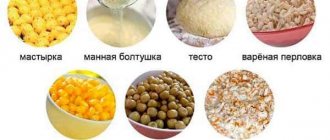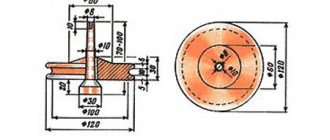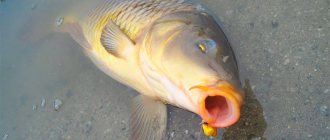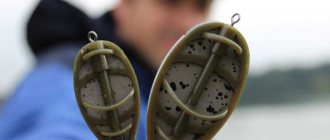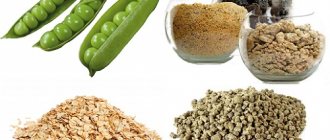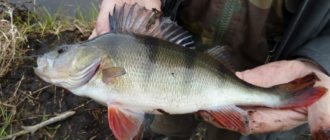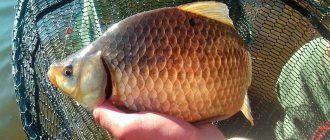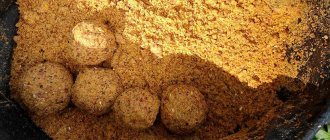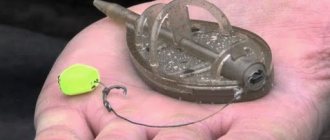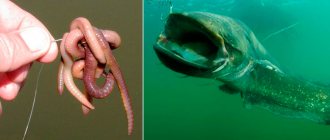Carp fishing is one of the most interesting and exciting types of fishing. This is due to the fact that carp is considered a strong fish and a specimen weighing about 2 kilograms provides serious resistance when fishing. This circumstance attracts many carp “hunting” enthusiasts.
Preparing potatoes for carp fishing
The most important thing is to choose a fresh root vegetable. Under no circumstances should you use rotten, moldy or frozen potatoes. It should be a root vegetable with a pleasant smell.
Potatoes are boiled in their skins, without peeling. Depending on the size of the potatoes, the cooking time is determined. It should be borne in mind that it should be a little damp. You can check readiness with a knife or toothpick. If the object enters the potato with little effort, it means it is ready. Once ready, drain the water and allow it to cool. As soon as the potatoes have cooled, they are peeled and then cut into cubes with sizes ranging from 1 to 3 cm. Cutting smaller is not recommended, since bites from smaller individuals are possible, and this is not so interesting.
Finally, the cubes are fried on all sides in unrefined sunflower oil until golden brown. This process not only enhances the flavor of the bait, but also makes it denser, allowing it to stay on the hook for a long time. At the same time, you should control the frying process, otherwise the cubes may burn.
To prevent the bait from losing its properties, it is placed in a jar with a tight-fitting lid. As a rule, the bait is prepared one day before going fishing.
How to properly cook potatoes for fishing.
How to choose potatoes for fishing
Age
Potato production is of key importance; you need to focus on it first.
Yes, the young vegetable is softer and more tender and therefore seems better for us, but not for the fish. As a bait, you need to choose old potatoes, because due to their initial rigidity, they will stick better to the hook when boiled. And, what is also important, it is juicier and therefore more attractive to fish. The color
of the potato indicates the concentration of starch in it. The yellower the vegetable, the more there is. And here it should be noted that fish, especially carp, love starch for its nutritional properties. So you should choose yellower potatoes. And the white and pink varieties can be left for planting or for food.
Size
potatoes does not matter much, since you will not plant them entirely. In any case, the vegetable will have to be either cut into pieces or pureed. So you can take several large potatoes, or small ones, but in larger quantities.
State
potatoes is very important, especially if you are going to plant them boiled. It is clear that a vegetable eaten by bugs, sprouted, or even rotten somewhere is not very convenient. In old potatoes, such “defects” are very common. But all this will have to be trimmed, which is time-consuming. So it’s better to immediately choose a clean vegetable in excellent condition, even if you have to overpay a couple of rubles for it.
Preparation of bait
For greater fishing results, it is necessary to feed the place in order to collect a sufficient amount of fish at one point.
To lure carp to the fishing spot, it is better to use his favorite corn, which he simply adores. The corn kernels are selected very carefully, with an emphasis on its integrity and freshness. Before cooking, the corn is soaked for a day or even two. It is boiled in a large amount of water for at least 4 hours. Once ready, the water is drained and the corn is placed in a hermetically sealed container.
In addition to corn, you can feed the carp with other equally attractive ingredients, such as makha, halva, and various cereals. The easiest way is to use store-bought bait. Shops and fishing departments have a wide range of dry, ready-to-use bait mixtures for catching all types of fish, including carp. It is enough to add the required amount of water to the dry mixture and stir. It is better to dilute the bait with water from the reservoir where fishing will be carried out.
Should you dye potatoes?
For fishing in those ponds mentioned above, potatoes are not painted. Carp also takes well to the simple, “yellow” color of potatoes. I dyed the potatoes a couple of times, but I didn’t feel any noticeable effect. This fact only convinced me more that for carp the nutritional value of the proposed bait is much more important than its “beautiful wrapper”. It is the freshness and calorie content of the bait that determine success, not dyes and attractants.
However, if you wish, you can, of course, color the potatoes - the dye will not spoil the food (at least not much).
And finally, let’s say a few words about storing potatoes. Peeled potatoes must be stored in water: without water, they quickly begin to darken and acquire a bitter taste. Unpeeled potatoes, on the contrary, should be kept away from water: if dropped into water, they quickly become soggy, limp, and become completely unsuitable for fishing.
We catch carp with potatoes!!!
Tackle for carp fishing on potatoes
Since carp is a rather shy and cautious fish, it does not come close to the shore. Therefore, in order to catch it, you should make long casts using a feeder rod at least 2.2 meters long. It is better to take a braided fishing line, with a reserve. As a rule, at least 100 m of fishing line is wound on the spool. The diameter of the cord is chosen so that it can withstand long casts with a heavy feeder.
For leashes, it is better to use leash material or use yellow nylon thread, about 0.15 mm thick. Nylon thread is softer, which means it will not alarm the fish.
Only classic carp hooks with a short shank are selected. If we take into account the European classification, then these will be hooks No. 3, and if the domestic classification is used, then hooks No. 12. The sinker is of the “bomb” type with a soldered swivel. The weight of the sinker can be within 70 g or more.
A carabiner is attached to the end of the main fishing line, and a piece of the same fishing line, about 30 cm long, is attached to it. A nipple tube is attached to the piece of fishing line. The diameter of the tube must be such that the load, which is secured with a swivel, moves along it. 3 swivels are attached to the other end, and in such a way that the fastening falls on the middle swivel. Leashes with hooks, 15-20 cm long, are attached to the first and third swivels.
Nozzle boiled potatoes. How to plant potatoes for fishing.
Cooking potatoes
For cooking, it is better to choose small or medium-sized potato tubers. In this case, you can use potatoes from both old and new harvests.
The selected potatoes are washed (no need to peel them), put in a saucepan and filled with cold water, then simmer over low heat in salted water until tender.
The finished tubers can be pierced with a fork without pressing hard. But under no circumstances should you allow the potatoes to become overcooked. Such tubers are suitable only for bait or for preparing baits by mixing with other components.
Where to catch carp using potatoes
Carp prefer to stick to deeper places where the bottom is strewn with shells, which are an excellent treat for carp. A similar place can be easily found if you drag a spoon along the bottom. If a shell is found on the tee, this means that this place can be considered promising.
Then you need to start feeding the carp. To do this, do the following:
- Basically, carp are caught in reservoirs with stagnant water, so the bait can be brought on a boat and scattered in the area where the bait will be thrown. If there is no boat, then you can roll out balls with a diameter of 10-15 cm and throw them to the fishing point. There are other ways to deliver bait to the intended fishing point.
- If fishing is carried out on the current, then the bait should be thrown at a distance of 20 m upstream from the intended fishing spot. How this will be done depends on the choice of the fishing enthusiast.
Fishing with potatoes or how to use potatoes as bait
Carp is a very popular fish among fishermen, so much so that hunting for it has become a separate area - carp fishing - with its own characteristics in the gear used and fishing tactics. A wide variety of baits are used for this fish - from the familiar corn and peas to boilies popular among athletes.
However, on some ponds, a rather unusual bait can demonstrate better results. Fishing with potatoes in some reservoirs is considered a curiosity, while in others it can be one of the most popular options. In this case, different types of potatoes can be used for fishing - some anglers prefer old yellowed ones, while others argue that, on the contrary, while it is possible to use young potatoes, it is better to fish with them, which is probably due to the peculiarities of the behavior of carp in different bodies of water.
However, on some ponds, a rather unusual bait can demonstrate better results. Fishing with potatoes in some reservoirs is considered a curiosity, while in others it can be one of the most popular options. In this case, different types of potatoes can be used for fishing - some anglers prefer old yellowed ones, while others argue that, on the contrary, while it is possible to use young potatoes, it is better to fish with them, which is probably due to the peculiarities of the behavior of carp in different bodies of water.
Technique for catching carp using potatoes
As a rule, the technique of catching carp with potatoes is not difficult; all you need is patience and endurance.
The method of fishing with potatoes includes the following operations:
- As soon as the place is fed, you can start casting the main gear. But before that, you need to inspect the gear (if this has not been done in advance) for the presence of abrasions, knots, etc.
- After the tackle is found to be suitable for use after inspection, the bait is baited. Both hooks are inserted into the potato cube so that they are not noticeable. In this case, you need to make sure that the cube does not fall apart into small pieces.
- With a smooth and precise movement of the rod, the nozzle is thrown to the fishing point.
- After casting, the fishing rod is placed on the stand, and the bite alarm (if electronic) is set to bite standby mode.
- The carp does not take the bait at once. He sucks her in slowly but surely. Therefore, if a bite is noticed, there is no need to immediately carry out any hooking. You need to wait a little until the carp swallows the bait as deeply as possible.
- The carp, sensing a foreign object, will try to spit it out. Considering that he has two hooks in his mouth at once, it is very difficult for him to do this. The result of his actions is self-cutting. After this, the carp will try to go deeper.
- At this moment, you should make a light, control hook, after which you need to start landing a large specimen. As a rule, only large individuals are caught using such cubes. In this case, you need to constantly keep the line in tension. If it is a large enough specimen, then you will have to tire it by constantly releasing the line. But this does not mean that he needs to be provided with complete freedom of movement, since he will immediately pull the tackle into snags or dense vegetation.
- You cannot pick up a carp with your hands, especially a large one. A carp angler should always have a landing net in his arsenal. Only he can guarantee complete catching of the carp.
Fishing with boiled potatoes: how to make bait from them
- Wash the vegetable and leave it in water for a minute (in newly collected water, of course). During this time, all the dirt will leave it, but it will not lose its taste.
- Place a saucepan of water on the stove and wait until it boils. After this, immerse the potatoes in it - directly with the peel, without peeling.
- Cook the vegetable, but not completely, but only until it can be pierced with the same match or toothpick. Do not overcook under any circumstances, otherwise the potatoes will no longer stick to the hook so well.
- Place the vegetable on a plate or bowl and let it cool. As soon as the potatoes become slightly warm, remove the skins from them, just do not delay this, as otherwise they will be worse to peel and the juice will release.
- Immediately cut the potatoes into cubes, with an edge of about 1 cm. This size is enough so that you don’t take the small stuff, and it won’t be too big.
To prevent the prepared bait from drying out, place the cubes in an airtight container with water and go fishing. By the way, you can even cook and cut the potatoes on the spot by boiling them in a pot. This “camping” option also has a right to life, it has its own charm.
By the way, cubes are not the only cutting option. You can make a ball-shaped potato bait using special scoop spoons or “syringes”. You can cut the cubes straight with the peel. In fact, much, if not all, depends on biting factors and, especially, on the preferences of the fish in this body of water. Whatever bait she is used to, this is the one she will bite on.
Separately, we note that there is no particular point in tinting potatoes. If a fish bites on it, it does so, but if not, a red or, for example, green plant bait will attract it just as weakly as a pale yellow one. So don’t add more work to yourself, don’t touch up.
Fishing with potatoes
Fishing with potatoes also brings excellent results if you know how to prepare them correctly.
The feeder's arsenal is rich not only in fashionable boilies, active maggots and aromatic corn. Fishing with potatoes also brings excellent results if you know how to prepare them correctly. This familiar vegetable is an excellent bait: carp and carp love it. And other fish are not averse to eating potatoes, so it is our duty to provide them. Naturally, remembering that the taste of a person and a crucian carp is different. So you still need to prepare potatoes for fishing, and we will tell you the recipe. But first, a few words about why, among all the variety of plant baits, you should choose this particular vegetable.
